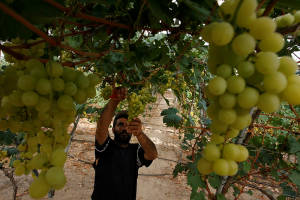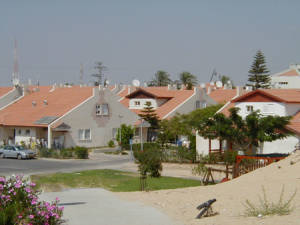With over 18,000 rockets launched from Gaza by Hamas since Israel left the Strip in 2005, the Gush Katif Museum is important to see.


Palestinian farmers harvest grapes from a field cultivated in the former Israeli community of Neve Dekalim in Gush Katif, which was dismantled in 2005. (File/Abed Rahim Khatib/Flash 90)
Right next to the Mahane Yehuda outdoor market in Jerusalem is a small but important place called the Gush Katif Museum. The museum tells about the fascinating connection of the Jewish people to the Gaza area from the time of Abraham and Sarah until 2005, when Israel uprooted its 21 Jewish communities there, known as Gush Katif (the Katif Bloc).
Visitors see photos and movies, and hear from guides about the beautiful and strong communities that existed near the Mediterranean Sea. These were communities known for their leadership in the Israeli army and for close connections and chesed (kindness) among all the residents. The communities were built by the Israeli government following the Six Day War in 1967 in order to increase security in the area.
Gush Katif was a place of miracles. When Jewish people first thought to grow produce in the salty and sandy soil near the sea, they were told they would sooner grow hair on the palm of their hands than they would succeed in growing anything there. But with God’s help, good thinking and a lot of hard work, they discovered how to grow flowers, peppers, cherry tomatoes, greens (even worm-free), and much more with special techniques. Gush Katif brought in a large amount of money to Israel’s economy by exporting this produce, and many saw it as the fulfillment of Biblical prophecies.

Menorah taken from a synagogue in a destroyed Gush Katif community to the museum. (Courtesy)
In the center of the museum is a Menorah that was taken down from the synagogue in Netzarim (in Gush Katif) and brought to the Western Wall straight from there on the night they were expelled. The teenagers led the movement to bring this to the Western Wall, even though they didn’t even know where they were going to sleep that night, having become homeless. The people of Gush Katif were amazing because despite the negative image of a menorah being removed from a synagogue and carried off (which evokes images of the destruction of the Temple in 70 by the Romans), they turned this negative image to something positive, saying, “Wherever we go, the light goes with us.”
The museum includes a memorial corner for those who were killed in Gush Katif. Despite the rocket attacks from Gaza, the community only grew stronger. And, of course, there were constant miracles. An entire book has been written on the miracle of the over 6,000 rockets that fell there from 2000 to 2005, resulting in very few casualties.
The museum has an orange section – dedicated to detailing the struggle against the disengagement. Orange (the color of the Gush Katif flag) became the color of those who opposed the disengagement plan. There are powerful photos of people who gathered from around Israel and abroad to show their opposition. While it was a painful and difficult time, many say it was also a remarkable time of coming together to show their love for the Land of Israel.
On one occasion, there was a human chain, with over 130,000 people holding hands from Gush Katif to the Western Wall in Jerusalem. In Gush Katif, at one end of the chain, was a grandfather. His daughter was at the other end. She put a note in the Wall, “Please, God, let me stay in my home.”

Founded in 1983, Neve Dekalim was the largest community in Gush Katif. (mkatif.org)
The museum also has a black section – dedicated to the few weeks of the actual destruction of Gush Katif in August 2005. At the end of the month, the cemetery also had to be uprooted, and loved ones were reburied in several places, including in a section on the Mount of Olives in Jerusalem. In many houses,the families would leave a message behind on the wall. In one house, the message said (paraphrase), “God, when you rebuild your house in Jerusalem, can you rebuild our house too?”
Like a visit to Yad Vashem Holocaust Memorial, a visit to the Gush Katif Museum can be difficult. But with over 18,000 rockets having been launched from the Gaza strip since Israel left, it’s an important and relevant place to see.
Gush Katif Museum – located on Shaarey Zedek 5, Jerusalem – is open 9:30 a.m. – 4:30 p.m. Sunday through Thursday, and 9 a.m.-12:30 p.m. Friday. Call ahead to arrange a tour at 02-625-5456.
By: Leah Bowman
(The author, a licensed tour guide, leads inspiring tours throughout Israel, including child-friendly and bible tours. Check out her website and blog page.










